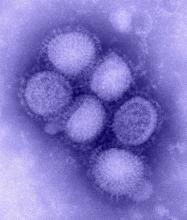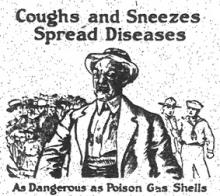Stop by the second floor of the Urbana Free Library to see the new Champaign County Historical Archives exhibit called "Champaign County and the Influenza Pandemic of 1918" on display now!
The H1N1 virus (above) was behind the flu pandemic of 1918.
The influenza pandemic of 1918, often referred to as the “Spanish flu,” infected over 500 million people worldwide and killed an estimated three to five percent of the world’s population. Unlike most influenza outbreaks, in which fatalities tend to strike the young and elderly, the flu pandemic of 1918 disproportionately killed young, healthy individuals. The flu struck in three waves, the second wave being a deadly mutation of the virus attributed in part to the conditions and circumstances created by World War I. The state of Illinois saw at least 350,000 infected and reached a death toll of 22,566 by the end of flu season.
The "Coughs and Sneezes Spread Diseases" public service announcement
appeared nationwide in newspapers and flyers during the 1918-1919 flu season.
Champaign County experienced the lethal second wave of the virus in late September and early October 1918. By early December, the flu had begun to dissipate. In addition to suffering many fatalities, the community endured the closings of public schools, theaters, and libraries, delays in postal service, emergency hospital construction, and an overall sense of panic during the fall and early winter of 1918.
-Donica, Archives Assistant


